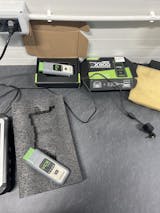DoIP Protocol Advantages in Automotive Diagnostics
The DoIP (Diagnostics over Internet Protocol) protocol is an Ethernet-based diagnostic communication standard designed to provide more efficient and flexible vehicle diagnostics than traditional vehicle diagnostic protocols like CAN bus. By using standard IP networks, it significantly enhances data transfer speed and adds a wide range of diagnostic functions, supporting complex tasks and remote operations. Below are the main advantages of DoIP protocol in automotive diagnostics:
-
Efficient Data Transfer
- High Bandwidth: DoIP utilizes Ethernet to provide data transfer speeds of up to 100 Mbit/s or higher. This is 100-200 times faster than traditional CAN bus, making large data transfers (like software updates and extensive fault records) much faster and more efficient. High bandwidth supports rapid data exchange to meet the complex diagnostic needs of modern vehicles.
- Fast Diagnostics: Due to its faster data transfer rate, DoIP can read and analyze vehicle diagnostic data, such as fault codes and sensor data, quickly. This leads to improved diagnostic efficiency, enabling technicians to identify and address issues more rapidly.
-
Flexibility and Scalability
- IP Network-Based: DoIP uses the standard TCP/IP protocol stack for communication, meaning it can conduct diagnostic operations over any device that supports an IP network, whether local or remote. This makes it easy to integrate with existing IT infrastructures and allows interoperability among various devices and systems, such as diagnostic tools, computers, and servers.
- Multi-ECU Support: DoIP supports multicast communication and service discovery, enabling communication with multiple electronic control units (ECUs) simultaneously. This is more efficient than traditional diagnostic protocols when dealing with complex vehicle systems, allowing diagnostics to be performed on multiple ECUs at once, reducing diagnostic time and increasing flexibility.
The VXDIAG SE device is an ideal choice supporting DoIP protocol and can be expanded to include multiple vehicle model authorizations. With factory-level diagnostic software support, the VXDIAG SE provides comprehensive diagnostic capabilities, including fault code reading and ECU programming.
-
Remote Diagnostics Support
- Remote Access: DoIP allows manufacturers or service providers to access vehicle diagnostic systems remotely via the internet. Remote diagnostics improve service efficiency by reducing the need for technicians to be physically present while also lowering the frequency of visits to service centers for diagnostics.
- Real-Time Monitoring & Preventive Maintenance: Through DoIP, vehicles can be monitored in real-time via the cloud, allowing technicians to identify potential faults and perform preventive maintenance, helping reduce costly repairs and improving vehicle reliability and lifespan.
-
Security
- Encryption and Authentication: DoIP supports encryption and authentication mechanisms to ensure secure data communications, preventing unauthorized access and data breaches. This is crucial for protecting critical vehicle systems and user data, ensuring the privacy and integrity of the diagnostic process while mitigating potential network security risks.
-
Cost-Effectiveness
- Low Hardware Costs: Compared to traditional diagnostic tools, DoIP requires fewer additional physical connection devices. A simple Ethernet interface is enough to establish a physical connection between diagnostic tools and computers. This reduces hardware costs, making automotive diagnostic equipment more affordable and providing a cost-effective solution for users.
- Reduced Repair Time and Costs: By improving diagnostic efficiency and minimizing downtime during repairs, DoIP helps save time and costs for both vehicle owners and service stations. Fast diagnostics, remote support, and real-time monitoring all contribute to a more efficient repair workflow.
-
Adaptation to Future Automotive Technologies
- Support for Complex Diagnostics: As automotive electronics and intelligence continue to evolve, vehicle diagnostics are becoming increasingly complex. DoIP can support more advanced diagnostic tasks, such as ECU programming, advanced fault diagnostics, and real-time data stream processing. As vehicle systems evolve, DoIP will be able to meet the growing demand for sophisticated diagnostics.
- Integration with IoT: DoIP’s integration with IoT (Internet of Things) technology helps vehicles become part of a connected ecosystem. Through DoIP, vehicles can interact with the IoT platform, enabling more efficient vehicle management, data exchange, and intelligent operations.
The VXDIAG SE device supports DoIP protocol and offers virtual authorization extensions for advanced tasks like ECU programming and key programming.
Conclusion DoIP protocol, based on Ethernet’s high bandwidth and standardized IP communication, provides an efficient, flexible, and secure diagnostic solution. It supports faster data transfer speeds, complex diagnostics, and remote operations, while also facilitating preventive maintenance. As automotive technology becomes more electronic and intelligent, DoIP’s role in automotive diagnostics will continue to grow, ensuring vehicles meet increasingly complex diagnostic demands. By integrating with IoT technologies, DoIP will help drive the automotive industry into a more connected and intelligent future.
DoIP protocol not only enhances diagnostic efficiency but also significantly reduces hardware costs, supporting future technological demands and ensuring the long-term stability of vehicles. For the automotive repair industry, DoIP is an indispensable technology for future vehicle diagnostics.
The VXDIAG SE device, compatible with DoIP protocol, provides strong support for all your automotive diagnostic needs, from basic maintenance to complex programming tasks.











